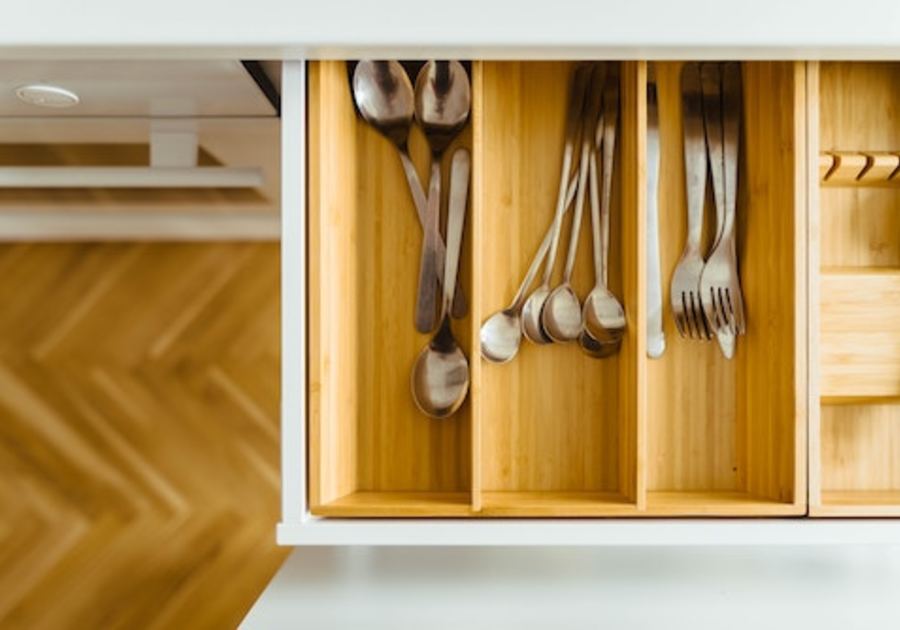We all have stuff. Big stuff. Little stuff. Cheap stuff. Expensive stuff. Stuff we got from our friends. Stuff we inherited from our parents.
Be it an overstuffed junk drawer in the kitchen, a troubled relationship with an estranged family member, or *ahem* a stack of pretty little notebooks that we buy compulsively whenever we visit HomeGoods, our stuff can cause us issues when we let it get out of hand. Whatever our stuff is, we either learn to control it, or it controls us.
Taking the time to organize your stuff can go a long way. But if the thought of tackling that dark, bulging corner of your life gives you the heebie jeebies, here are 5 simple steps you can use to organize anything in your life.
1. Create the space
Think of this as the step before the first step. A pre-step, if you will. It’s not always obvious, but it is essential if you want to work through your stuff in as little time possible and with your sanity intact. Before you start organizing anything, set aside or create a designated space where the organizing will happen.
If you’re organizing physical objects, then you need to clear a physical space somewhere. That could be in your home, office, or car (junk in the trunk, anyone?). If you’re organizing digital information, like photos on your computer or the scores of partially drafted blog posts you’ve started, then the space might be a new file folder on your desktop or in your Google Drive. If you’re trying to organize something more ephemeral like your thoughts or feelings, think about creating space in your calendar, to give yourself a block of uninterrupted time to do the work.
Everything needs room to breathe. Be sure to give yourself enough room to spread out as you unpack your bags (or boxes or drawers).
2. Examine everything
Once you’ve created the space, you can get to the real work. The first phase is examining everything in the space. Before you can actively sort anything, you have to know what it is you’re dealing with. So bring everything to light and give it an honest look-over. The point of this step isn’t to do anything with your stuff yet. Rather, it’s all about figuring out what everything is, and identifying your relationship with each element.
I can’t over-emphasize how important it is to go all the way with this step. Even if you think you know what’s in that drawer, box, bag, or memory, you still need to dump it all out and review it. Why? Because sometimes things change when we’re not paying attention. Because sometimes we forget what we have or misplace things, and the act of looking closely can help us rediscover what we’ve lost. Because sometimes we try to avoid dealing with things by pretending they don't exist.
You can’t organize what you aren’t willing to confront. Commit to seeing your stuff for what it is. You can decide what to do with it later.
3. Get rid of what doesn’t belong
After you’ve examined your stuff, the next step is to purge what you know you no longer want or need. If it’s irreparably damaged, worn out, doesn’t fit, or causes you constant pain, heartache, or frustration, it probably needs to go.
There’s no point in further sorting through items or ideas that don’t serve you, and there are two immediate payoffs for purging them. First, it creates more capacity for the things that do matter, for those things you unequivocally know you want or need to keep. Second, you’ll create much-needed bandwidth to deal with your more complicated stuff—you know, those things that you aren’t sure about and the tough things that will require more energy to process.
Still, purging can be hard. It’s not easy to get rid of otherwise useless items that hold sentimental value for us. And if you’re generally afraid of not having enough in life, getting rid of anything can trigger feelings of guilt or fear. Just remind yourself that more is not necessarily better, and focus on what actually creates value in your life, not just what you wish brought you value.
This is also a good time for me to clear up a common misconception. Letting go of something is not an act of judgment. It’s an act of liberation. Saying that something doesn’t serve you in the present doesn’t negate the fact that it may have served you in the past. And acknowledging that an item or idea isn’t of value to you doesn’t have to mean that it can’t be of value to others. Your purge is about you. Free yourself from the burden of the broken, outdated, unnecessary, impractical, and undesirable by letting go.
4. Make sense of what’s left
After you’ve gotten rid of what doesn’t belong, it’s time to deal with what remains. This step will look different for every project, but there are some general principles you can use as a guideline.
First, give everything you’re going to keep a home—a place where it ‘lives’ so that you always know where to go when you need it. Things you need often should be easily accessible to you. Things that bring you joy should be more visible and top of mind. And since it’s your stuff, give it a home that works in the context of your life, not just where you think it should go. Once you figure out where everything will live, put it there.
Next, set aside the things that need additional action, and group them accordingly. Items that need to be repaired don’t belong with items that are fully functional. Stuff that needs to be further processed—cleaned up, discussed with someone, or even dealt with in therapy—shouldn’t be shoved back into a dark corner to be forgotten. If it’s not worth maintaining, then it’s not worth keeping. Determine how and when you will deal with your stuff, and then set aside the time to follow up.
Somewhere between examining everything, purging, and sorting your stuff, you might identify some things that need to be replaced, or some things that are missing altogether. Be sure to keep track of what you need, and then make a game plan to go get it.
5. Protect the system
If step one is the pre-step, this is the post-step—and it’s essential for getting ongoing results. After you’ve done the work of sorting through your stuff, getting rid of what doesn’t belong and organizing what’s left, it’s important to keep applying the same principles to anything new that comes your way.
Examine it. If it doesn’t serve you, discard it. If it does, give it a home and put it there. If it needs work, set aside the time to deal with it and then follow through. Failing to do this on an ongoing basis allows chaos to creep in, derailing all of the progress you’ve made. (This explains the constant state of disarray in my closet, by the way.)
There’s no right or wrong way to get organized. You can pile, file, and label to your heart’s content. (I prefer to make lists in pretty notebooks or on sticky notes.) However you decide to work with—or through—your stuff, remember to be honest and authentic every step of the way. Enlist help when you need it, and design a system you can live with.
Now that you’ve got a game plan, what’s the next organization project you can tackle to bring more order, efficiency, and fulfillment to your life?
Elizabeth C. Burrows, who founded the Life Edit Project, is a recovering busy-body and overachiever. She spent the first three decades of her life trying to wear as many hats as she could before becoming a mother and almost failing at life under the self-imposed pressure of doing too much. She has since learned how to sift through life’s noise to focus on what matters most to her. Now, her life is set up to revolve around the people, priorities and potential that leave her feeling content and fulfilled.



